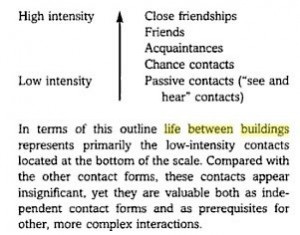ABOUT THE AUTHOR:
Life between buildings was written by, the Danish architect and urban design consultant, Jan Gehl who is based in Copenhagen, Denmark where he was also born (1936). Gehl is known for emphasizing on the enhancement city design through concentrating more on the pedestrians and cyclists. He has also received awards such as the Sir Patrick Abercrombie Prize (1993) and Civil Trust Award (2009). In addition to this, he received funding to do a research on “studies of the form and use of public spaces.” As a result of this, he became a lecturer and professor in the Royal Danish Academy of Fine Arts. Also, he was a visiting professor in different countries such as Canada, Australia and Norway. He is also the co-founder of Gehl Architects.
Jan Gehl got married to a psychologist who shared the same curiosity on the lack of thought on the human aspect of architecture by the architects, landscape architects and planners. Therefore, both he and his wife dedicated themselves to understanding the boundary between sociology, psychology, architecture and planning.
Book Publishing Date: Year 1987
SUMMARY:
Life between Buildings by Jan Gehl discusses about two key points that is related to the vivacity amidst the buildings. One is the “need for contact” and another is the “need for stimulation.”
What exists between buildings are public spaces. These are areas where people are exposed to one another; seeing, hearing and experiencing them as they behave in different circumstances. According to Gehl, this contact between people in public spaces differs in intensity which creates a vibrant diversity. In addition to this, Gehl also mentioned that various opportunities start to exist as people are in contact with each other within public spaces.
The opportunities that are associated with just being able to encounter, see and hear another person involves:
- contact at a modest level
- a potential beginning for contact at another level
- a chance of maintaining an already existing contact with others
- an informant about the outside social realm
- a source of inspiration, a source of stimulating experience
Through this, a variety of interaction intensity between individuals were illustrated in the diagram below by Gehl. In the diagram most of the opportunities are referred to as a certain key word. On the other hand, some of opportunities can occur no matter what level of interaction the individuals are in.
As shown in the diagram above, the lowest intensity of interaction between people is called passive contact. It is the ordinary opportunity that an individual have in their daily lives. It can also be referred to as merely co-existing within a space. According to Gehl, this can be explained further through comparison of the actions of children within a playground. A child who comes to a playground does what they want to do although there are other children surrounding them. They may or may not play together but they are still in the same place. Similarly, people in public spaces are present there for their individual reasons. Although this interaction might not evolve into something more than merely co-existing, this does not affect their purpose of being present within the same space. However, this type of contact does have a possibility of developing into a more intense interaction within certain circumstances.
An interaction between people can intensify when a public space is common for the individuals involved. It occurs more within neighborhoods as they tend to do activities within a common area which increases the ‘chance’ of contact even though there was no intention to do so. It is, as Gehl mentioned, similar to children who have been in the playground playing individually and eventually starting to play together. It may seem like it is planned, however, it is usually not. Through this, it can again stay as is or progress into a higher level.
People within neighborhoods tend to frequently encounter each other within streets and may start to converse with each other. This then becomes the stage of being acquaintances. An example of this is when a child recognizes another from a previous visit to the playground, they tend to play with them eventually but the process is shorter than the ‘chance contact’. As Gehl mentioned, if this contact occurs again more and more, be it intentionally or not, it will intensity the interaction into friendships. This highest level of intensity is seen as an easier interaction as there is no pressure to be in touch just to maintain this type of relationship with individuals.
Throughout the changes of the intensity of people’s interaction within spaces, there was a common occurrence. It was the existence of experience for the individuals within the space. People within a public space tend to get ideas by just being exposed to the surroundings and other people. Another can get information about what is happening around them by being in contact with individuals or even conversing with them. Through all this, different experiences is given to people which stimulates certain aspects of their being that they intentionally or unintentionally wanted to be stirred.
Reference:
LeGates, R. & Stout, F. (24 Feb 2011). Life between Buildings by Jan Gehl. The City Reader Fifth Edition. Routledge.
Relevance to Doha:
As Qatar is aiming to have an education economy for its future, it is important to realize that encounter between individuals is important for both the sharing knowledge and creating experiences for the present and future generation. In addition to this, it is interesting how the exemplification of these interactions through children was done by Jan Gehl as we know that now-a-days people tend to be on their phones and on social media. As a result of this, there is a decrease in physical interaction between people which could potentially create a better experience not just for the residents but also for the visiting individuals within the country.
Published by: Angelica Caccam


